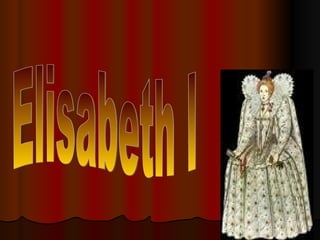
Isabel I
- 1. Elisabeth I
- 2. Elizabeth I - the last Tudor monarch - was born at Greenwich on 7 September 1533, the daughter of Henry VIII and his second wife, Anne Boleyn. Her early life was full of uncertainties, and her chances of succeeding to the throne seemed very slight once her half-brother Edward was born in 1537. She was then third in line behind her Roman Catholic half-sister, Princess Mary.
- 3. Elizabeth succeeded to the throne on her half-sister's death in November 1558. She was very well-educated (fluent in six languages), and had inherited intelligence, determination and shrewdness from both parents. Her 45-year reign is generally considered one of the most glorious in English history.
- 4. Most of her subjects accepted the compromise as the basis of their faith, and her church settlement probably saved England from religious wars like those which France suffered in the second half of the 16th century. Although autocratic and capricious, Elizabeth had astute political judgement and chose her ministers well; these included Burghley (Secretary of State), Hatton (Lord Chancellor) and Walsingham (in charge of intelligence and also a Secretary of State). The image of Elizabeth's reign is one of triumph and success. The Queen herself was often called 'Gloriana', 'Good Queen Bess' and 'The Virgin Queen'.
- 5. Investing in expensive clothes and jewellery (to look the part, like all contemporary sovereigns), she cultivated this image by touring the country in regional visits known as 'progresses', often riding on horseback rather than by carriage. However, Elizabeth's reign was one of considerable danger and difficulty for many, with threats of invasion from Spain through Ireland, and from France through Scotland. Much of northern England was in rebellion in 1569-70. A papal bull of 1570 specifically released Elizabeth's subjects from their allegiance, and she passed harsh laws against Roman Catholics after plots against her life were discovered. One such plot involved Mary, Queen of Scots, who had fled to England in 1568 after her second husband's murder and her subsequent marriage to a man believed to have been involved in his murder.
- 6. As a likely successor to Elizabeth, Mary spent 19 years as Elizabeth's prisoner because Mary was the focus for rebellion and possible assassination plots, such as the Babington Plot of 1586. Mary was also a temptation for potential invaders such as Philip II. In a letter of 1586 to Mary, Elizabeth wrote, 'You have planned ... to take my life and ruin my kingdom ... I never proceeded so harshly against you.' Despite Elizabeth's reluctance to take drastic action, on the insistence of Parliament and her advisers, Mary was tried, found guilty and executed in 1587. In 1588, aided by bad weather, the English navy scored a great victory over the Spanish invasion fleet of around 130 ships - the 'Armada'. The Armada was intended to overthrow the Queen and re-establish Roman Catholicism by conquest, as Philip II believed he had a claim to the English throne through his marriage to Mary. During Elizabeth's long reign, the nation also suffered from high prices and severe economic depression, especially in the countryside, during the 1590s. The war against Spain was not very successful after the Armada had been beaten and, together with other campaigns, it was very costly.
- 7. However, the 'Virgin Queen' was presented as a selfless woman who sacrificed personal happiness for the good of the nation, to which she was, in essence, 'married'. Late in her reign, she addressed Parliament in the so-called 'Golden Speech' of 1601 when she told MPs: 'There is no jewel, be it of never so high a price, which I set before this jewel; I mean your love.' She seems to have been very popular with the vast majority of her subjects. Overall, Elizabeth's always shrewd and, when necessary, decisive leadership brought successes during a period of great danger both at home and abroad. She died at Richmond Palace on 24 March 1603, having become a legend in her lifetime. The date of her accession was a national holiday for two hundred years.
- 8. THE END
